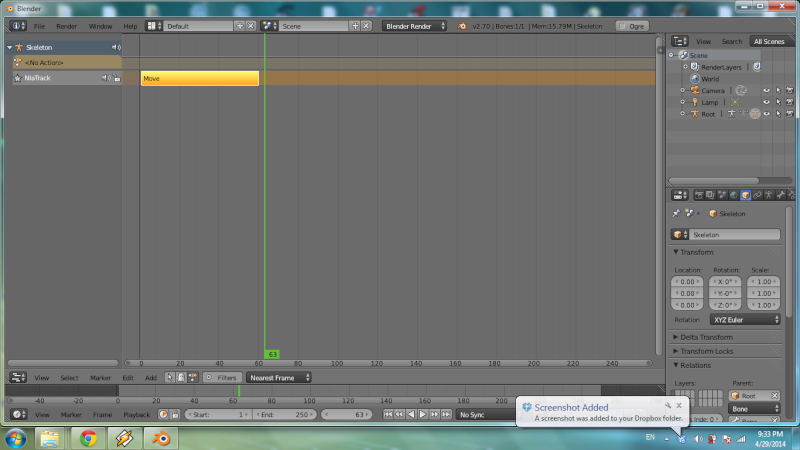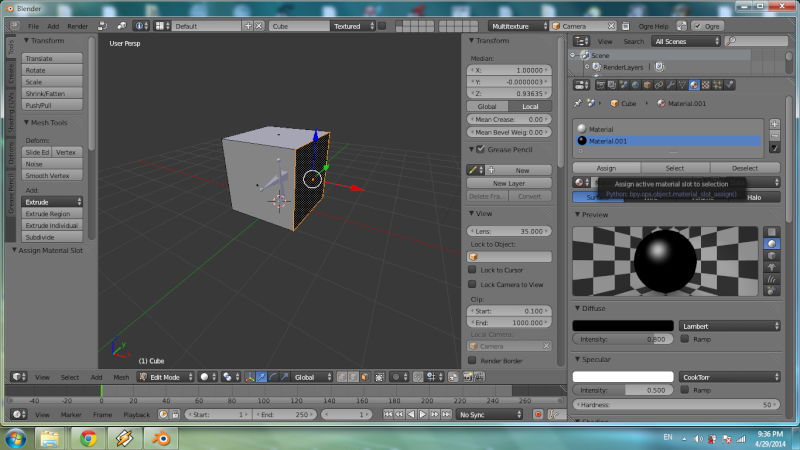Belnder v2.70 is used in this tutorial.
In this tutorial i'l explain the basics of creating and exporting a model to ogre. Crovea has the tools to export and convert the files from blend file but if you would like to make his life a bit easier you would need this:
-Blender exporter plugin
- Link:
https://code.google.com/p/blender2ogre/downloads/list
Tested with version 6.0. The download comes with a "readme" file that explains how to install this into blender.
-Ogre XML converter a simple exe file you drag and drop the "model.mesh" and "model.skeleton" into to get a .mesh file from a .mesh.xml
- Link:
http://www.ogre3d.org/tikiwiki/OgreXmlConverter
Download the "OgreCommandLineTools for Windows" file and extract somewhere.
Now lets get started with Blender and make something really simple
- pic 1:
I've moved the box up Z a little and added armature, now this armature is our Root it MUST always be vertical then added another armature and named it "skeleton"
- pic 2:
Select mesh shift select skeleton armature press Ctrl-P and join them with automatic weights then attach skeleton to root - bone.
- pic 3:
Now lets apply Location Rotation Scale with Ctrl-A for the mesh and then for the 2 armatures! NEVER FORGET THIS!
- pic 4:
TAKE NOTE your model must have 1 mesh, you can merge meshes with Ctrl-J into 1 mesh.
To animate: Select the "skeleton" armature and go to 'Dope Sheet' editor then to 'Action Editor' mode, click the new action button and name it however you want.
- pic 5:
I've just animated the box to move left and right and won't show the process or the result i'll assume the user reading this knows basic blender animation and if not there are way better tutorials online here we discuss mainly what OGRE needs. Just remember we are not animating the Root armature but the one connected with the mesh in this case "skeleton".
When you're done animating go to NLA Editor above the Dope Sheet
- pic 6:
you should see your action name there, click the snow icon
- pic 7:
If you want to make another animation go back to dope sheet-action editor-new action and make your animation in the next keyframes so lets say the first animation was in the interval 1-60 the next needs to start atleast from 61-something!
- pic 8:
Lets me say something about the Materials. This thing here has to be on it enables Ogre UI in the bottom of the materials tab.
- pic 9:
The material properties should be applied in there, now you can use the normal options and they'll translate in the Ogre options but many features wont.
Assigning multiple materials to one mesh is done like this: New material->add new material slot-> add new material configure your materials then select mesh and enter Edit Mode you'll get 3 new buttons in materials window "Assign" "Select" "Deselect"
- pic 10:
In edit mode you select faces and apply any material you like with "Assign".
Now you are ready to Export the model with the Blender2Ogre plugin! If the plugin was installed correctly you should be able to select Ogre3D (.scene and .mesh) under export. Select settings similar to these for the exporting:
- pic 10:
This will should give you a .mesh.xml and a .material file, you then drag and drop the .mesh.xml file onto "OgreXMLConverter.exe" which turns it into a .mesh file. You now have a .mesh and a .material file which is all ogre needs! In some cases an image file for the texture will also be included if one was used.
Extra notes:
- Try to name things appropriately such that the mesh isn't simply called "Cube", instead call it "KillerOrganelle" and instead of the material being called "Blue" name it "KillerOrganelleMaterial"
- Avoid spaces in names as they cause problems during exporting
Edit: We need to modify our current models to these requirements, as they are not animated no armature is needed at all, just merging the meshes to one and apply transformations "ctrl-A" but the materials are using blender generated textures and we can't export them. One solution i'm thinking of is somehow getting the texture to jpg, png, bmp and UV mapping them.

 by
by 












